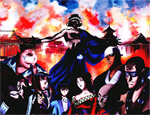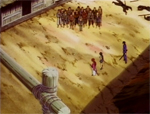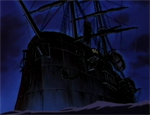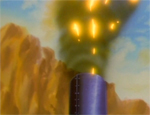|
Objectives
Shishio is a very astute and ambitious man and the chaos of the revolution was one of his main influences for taking over Japan. Deeply infuriated by the tactics of the Mejii government, his quest for revenge tested his patience and accentuated his intelligence. He claimed that he had no intention of seeking vengeance once questioned by Kenshin Himura, but those intentions still remain questionable. He said he was actually grateful for what they did because his wounds had taught him many valuable lessons in life: trust will be betrayed, let down your guard and you�re a dead man, kill or be killed, and women will always find a man attractive no matter what happens to him once he has power.
For years he lived within the shadows devising and piecing together his plans to overthrow the Mejii. He thought the government was weak and that the land should be ruled by a more suitable leadership, one such as him. He assembled ten of the best warriors in Japan, gaining avid lower rank followers as his plans slowly began to flourish.
Shishio envisioned Japan being ruled by his hands where he would govern the land with his own harsh ideals, ideals that vastly surrounded his delusion of the strong always overcoming the weak. He calculated the country will become stronger under his leadership, the justice that will guide him through his noble cause.
 His elite force - His first move was setting up the elite team of strong warriors that he sought out throughout Japan. He compiled a group of ten, each person contrasting to each other in skill and personality. Each one of them served a beneficial role in the progress of his strong regime. He called the group the Juppongatana. His elite force - His first move was setting up the elite team of strong warriors that he sought out throughout Japan. He compiled a group of ten, each person contrasting to each other in skill and personality. Each one of them served a beneficial role in the progress of his strong regime. He called the group the Juppongatana.
 Toshimichi Okubo�s assassination - He had Lord Okubo, the Mejii Secretary of the Interior, assassinated because of his interference, defiance and willingness to stand out against him. As a result, he crippled all the other government officials with fear crushing any plans they had of bringing his goals to an end. They refused to oppose him, in fear of suffering the same fate. Toshimichi Okubo�s assassination - He had Lord Okubo, the Mejii Secretary of the Interior, assassinated because of his interference, defiance and willingness to stand out against him. As a result, he crippled all the other government officials with fear crushing any plans they had of bringing his goals to an end. They refused to oppose him, in fear of suffering the same fate.
 The Villages - During all this, he proceeded to seize Japan under his control piece by piece. He took hold of ten villages and proceeded in the capture of more. One of the first villages he captured was called Shingetsu Village. The village was overseen by Senkaku, one of his lower ranking men. Besides his escalating thirst for power, Shishio�s main reason for enslaving the village was to acquire the use of the hot springs every six months, which eases the painful sensations from his burns. The other reason was to use it as a military headquarters to plan out a move on taking over the Tokai district. However, the people of the village became caught in his wrath and could not leave, being forced to live in fear for their lives as they obeyed his commands. Anyone who disobeyed orders received a punishment by death, executed as a warning for the others to witness. Intimidated by his strength and influence, all villages seized by Shishio were automatically abandoned by the government. Confrontation was futile, since every police officer assigned was slain by Shishio�s men. In fact, all outsiders were automatically slain by the request of Shishio and Senkaku to avoid any disruptions. Proof of this became evident once the villages no longer became printed on the maps. The Villages - During all this, he proceeded to seize Japan under his control piece by piece. He took hold of ten villages and proceeded in the capture of more. One of the first villages he captured was called Shingetsu Village. The village was overseen by Senkaku, one of his lower ranking men. Besides his escalating thirst for power, Shishio�s main reason for enslaving the village was to acquire the use of the hot springs every six months, which eases the painful sensations from his burns. The other reason was to use it as a military headquarters to plan out a move on taking over the Tokai district. However, the people of the village became caught in his wrath and could not leave, being forced to live in fear for their lives as they obeyed his commands. Anyone who disobeyed orders received a punishment by death, executed as a warning for the others to witness. Intimidated by his strength and influence, all villages seized by Shishio were automatically abandoned by the government. Confrontation was futile, since every police officer assigned was slain by Shishio�s men. In fact, all outsiders were automatically slain by the request of Shishio and Senkaku to avoid any disruptions. Proof of this became evident once the villages no longer became printed on the maps.
 Setting Kyoto on Fire � Once Shishio was successful in seizing a few villages, he summoned the members of the Juppongatana to prepare for the hostile takeover of Japan. He decided to duplicate the Ikedaya affair that was thwarted by the Shinsengumi ten years ago to erupt Kyoto in flames. He systematically plotted for the fire to commence at 11:59 pm. That way, in the midst of the chaos of the fire, he would be able to kill off all of his key targets, most of them being officials. To get back at the Imperialists who burnt him alive, he basically threw their same concocted plan from the past right back in their faces. Setting Kyoto on Fire � Once Shishio was successful in seizing a few villages, he summoned the members of the Juppongatana to prepare for the hostile takeover of Japan. He decided to duplicate the Ikedaya affair that was thwarted by the Shinsengumi ten years ago to erupt Kyoto in flames. He systematically plotted for the fire to commence at 11:59 pm. That way, in the midst of the chaos of the fire, he would be able to kill off all of his key targets, most of them being officials. To get back at the Imperialists who burnt him alive, he basically threw their same concocted plan from the past right back in their faces.
 The Purgatory � The Kyoto grand fire was just a diversion to overshadow Shishio�s true intentions; intentions that were even kept hidden from the Juppongatana themselves, except for his most trusted few. Repeating history seems to appeal to Shishio and in a sense of irony, he decided to follow the tactics of the shogun Yoshinobu Tokugawa by abandoning his allies and retreating by boat using his battleship he prepared called the Purgatory. He planned to bombard Tokyo by ship in a further step to completing his goals and since most of the government�s manpower will be focused on controlling the fire, there would be no one in the way to stop him. The Purgatory � The Kyoto grand fire was just a diversion to overshadow Shishio�s true intentions; intentions that were even kept hidden from the Juppongatana themselves, except for his most trusted few. Repeating history seems to appeal to Shishio and in a sense of irony, he decided to follow the tactics of the shogun Yoshinobu Tokugawa by abandoning his allies and retreating by boat using his battleship he prepared called the Purgatory. He planned to bombard Tokyo by ship in a further step to completing his goals and since most of the government�s manpower will be focused on controlling the fire, there would be no one in the way to stop him.
 Petroleum � One of Shishio�s investments involved the eventual use of Petroleum, an energy source derived from the western nations. The more advanced nations were currently researching its use as a power source that can be used to replace coal. Once Shishio gained control of Japan, he planned to put Petroleum to good use and use it as a foothold to step out into the world. Petroleum � One of Shishio�s investments involved the eventual use of Petroleum, an energy source derived from the western nations. The more advanced nations were currently researching its use as a power source that can be used to replace coal. Once Shishio gained control of Japan, he planned to put Petroleum to good use and use it as a foothold to step out into the world.
 Fighting the Battousai � The one obstacle that seemed to hinder Shishio�s path to triumphant glory was his predecessor Kenshin Himura. He brought that much of a challenge to Shishio that defeating him became almost as important as taking over Japan. He decided to make their battle an important agenda, proposing a duel at his true headquarters, Mount Hiei at the shrine of six archways. With the help of his Juppongatana allies he planned the battle out strategically, hoping to accomplish 100% victory. Fighting the Battousai � The one obstacle that seemed to hinder Shishio�s path to triumphant glory was his predecessor Kenshin Himura. He brought that much of a challenge to Shishio that defeating him became almost as important as taking over Japan. He decided to make their battle an important agenda, proposing a duel at his true headquarters, Mount Hiei at the shrine of six archways. With the help of his Juppongatana allies he planned the battle out strategically, hoping to accomplish 100% victory.
Small villages, the police force, the military, and the government � all to be controlled by Shishio�s will. That was the means behind his objectives. No matter the obstacles that stood in his way, he never once conceived of giving up and that�s what made Shishio truly a mastermind.
|

 His elite force - His first move was setting up the elite team of strong warriors that he sought out throughout Japan. He compiled a group of ten, each person contrasting to each other in skill and personality. Each one of them served a beneficial role in the progress of his strong regime. He called the group the Juppongatana.
His elite force - His first move was setting up the elite team of strong warriors that he sought out throughout Japan. He compiled a group of ten, each person contrasting to each other in skill and personality. Each one of them served a beneficial role in the progress of his strong regime. He called the group the Juppongatana. Toshimichi Okubo�s assassination - He had Lord Okubo, the Mejii Secretary of the Interior, assassinated because of his interference, defiance and willingness to stand out against him. As a result, he crippled all the other government officials with fear crushing any plans they had of bringing his goals to an end. They refused to oppose him, in fear of suffering the same fate.
Toshimichi Okubo�s assassination - He had Lord Okubo, the Mejii Secretary of the Interior, assassinated because of his interference, defiance and willingness to stand out against him. As a result, he crippled all the other government officials with fear crushing any plans they had of bringing his goals to an end. They refused to oppose him, in fear of suffering the same fate. The Villages - During all this, he proceeded to seize Japan under his control piece by piece. He took hold of ten villages and proceeded in the capture of more. One of the first villages he captured was called Shingetsu Village. The village was overseen by Senkaku, one of his lower ranking men. Besides his escalating thirst for power, Shishio�s main reason for enslaving the village was to acquire the use of the hot springs every six months, which eases the painful sensations from his burns. The other reason was to use it as a military headquarters to plan out a move on taking over the Tokai district. However, the people of the village became caught in his wrath and could not leave, being forced to live in fear for their lives as they obeyed his commands. Anyone who disobeyed orders received a punishment by death, executed as a warning for the others to witness. Intimidated by his strength and influence, all villages seized by Shishio were automatically abandoned by the government. Confrontation was futile, since every police officer assigned was slain by Shishio�s men. In fact, all outsiders were automatically slain by the request of Shishio and Senkaku to avoid any disruptions. Proof of this became evident once the villages no longer became printed on the maps.
The Villages - During all this, he proceeded to seize Japan under his control piece by piece. He took hold of ten villages and proceeded in the capture of more. One of the first villages he captured was called Shingetsu Village. The village was overseen by Senkaku, one of his lower ranking men. Besides his escalating thirst for power, Shishio�s main reason for enslaving the village was to acquire the use of the hot springs every six months, which eases the painful sensations from his burns. The other reason was to use it as a military headquarters to plan out a move on taking over the Tokai district. However, the people of the village became caught in his wrath and could not leave, being forced to live in fear for their lives as they obeyed his commands. Anyone who disobeyed orders received a punishment by death, executed as a warning for the others to witness. Intimidated by his strength and influence, all villages seized by Shishio were automatically abandoned by the government. Confrontation was futile, since every police officer assigned was slain by Shishio�s men. In fact, all outsiders were automatically slain by the request of Shishio and Senkaku to avoid any disruptions. Proof of this became evident once the villages no longer became printed on the maps. Setting Kyoto on Fire � Once Shishio was successful in seizing a few villages, he summoned the members of the Juppongatana to prepare for the hostile takeover of Japan. He decided to duplicate the Ikedaya affair that was thwarted by the Shinsengumi ten years ago to erupt Kyoto in flames. He systematically plotted for the fire to commence at 11:59 pm. That way, in the midst of the chaos of the fire, he would be able to kill off all of his key targets, most of them being officials. To get back at the Imperialists who burnt him alive, he basically threw their same concocted plan from the past right back in their faces.
Setting Kyoto on Fire � Once Shishio was successful in seizing a few villages, he summoned the members of the Juppongatana to prepare for the hostile takeover of Japan. He decided to duplicate the Ikedaya affair that was thwarted by the Shinsengumi ten years ago to erupt Kyoto in flames. He systematically plotted for the fire to commence at 11:59 pm. That way, in the midst of the chaos of the fire, he would be able to kill off all of his key targets, most of them being officials. To get back at the Imperialists who burnt him alive, he basically threw their same concocted plan from the past right back in their faces.  The Purgatory � The Kyoto grand fire was just a diversion to overshadow Shishio�s true intentions; intentions that were even kept hidden from the Juppongatana themselves, except for his most trusted few. Repeating history seems to appeal to Shishio and in a sense of irony, he decided to follow the tactics of the shogun Yoshinobu Tokugawa by abandoning his allies and retreating by boat using his battleship he prepared called the Purgatory. He planned to bombard Tokyo by ship in a further step to completing his goals and since most of the government�s manpower will be focused on controlling the fire, there would be no one in the way to stop him.
The Purgatory � The Kyoto grand fire was just a diversion to overshadow Shishio�s true intentions; intentions that were even kept hidden from the Juppongatana themselves, except for his most trusted few. Repeating history seems to appeal to Shishio and in a sense of irony, he decided to follow the tactics of the shogun Yoshinobu Tokugawa by abandoning his allies and retreating by boat using his battleship he prepared called the Purgatory. He planned to bombard Tokyo by ship in a further step to completing his goals and since most of the government�s manpower will be focused on controlling the fire, there would be no one in the way to stop him. Petroleum � One of Shishio�s investments involved the eventual use of Petroleum, an energy source derived from the western nations. The more advanced nations were currently researching its use as a power source that can be used to replace coal. Once Shishio gained control of Japan, he planned to put Petroleum to good use and use it as a foothold to step out into the world.
Petroleum � One of Shishio�s investments involved the eventual use of Petroleum, an energy source derived from the western nations. The more advanced nations were currently researching its use as a power source that can be used to replace coal. Once Shishio gained control of Japan, he planned to put Petroleum to good use and use it as a foothold to step out into the world. Fighting the Battousai � The one obstacle that seemed to hinder Shishio�s path to triumphant glory was his predecessor Kenshin Himura. He brought that much of a challenge to Shishio that defeating him became almost as important as taking over Japan. He decided to make their battle an important agenda, proposing a duel at his true headquarters, Mount Hiei at the shrine of six archways. With the help of his Juppongatana allies he planned the battle out strategically, hoping to accomplish 100% victory.
Fighting the Battousai � The one obstacle that seemed to hinder Shishio�s path to triumphant glory was his predecessor Kenshin Himura. He brought that much of a challenge to Shishio that defeating him became almost as important as taking over Japan. He decided to make their battle an important agenda, proposing a duel at his true headquarters, Mount Hiei at the shrine of six archways. With the help of his Juppongatana allies he planned the battle out strategically, hoping to accomplish 100% victory.